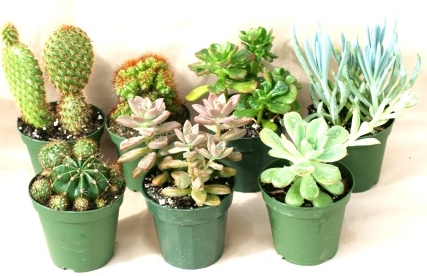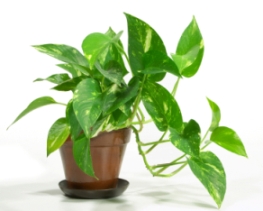Houseplants
not even YOU can KILL...!!!
Okay, so I already know what you're
thinking. Yea right Jimmie you don't know me, I can kill anything!! Believe me,
being in my business I have heard it all from clients! However I have a list of
six or seven really hearty houseplants that you would have to try really hard
to kill. Not that you wouldn't be successful with enough dedicated neglect but
I have seen people leave for the summer and come back to these plants basically
saying " Is that all you got?" Let's take a look at some of these
tougher than nails houseplants that will keep your green thumb confident!
Golden pothos
vine (Epipremnum pinnatum 'aureum')
There's a
reason this vine is one of the most popular hanging plants around. In its
native habitat, golden pothos grows into a tree-swallowing monster with huge
yellow and green leaves. As a houseplant, the plant will grow aggressively from
pots or trailing baskets with minimal care. They will easily root in a simple
glass of water. With better care, large, mottled, mature leaves may actually develop
for you.
Spider plant (Chlorophytum)
A well-grown
spider plant is a magnificent thing. The plant grows easily in baskets or atop
columns, with arching leaves. The variegated variety is by far the most common.
Over time, a mature plant will send out plantlets or offsets on long stems that
form an impressive hanging display. These plantlets can be easily potted up to
create new specimens. Spider plants are not picky about water, light,
temperature or that huge spider web that's been growing near it for the last
three months you just haven't got around to yet..
Actually in the
same family that includes dracaena and liriope, there are many varieties of
sansevieria that are exceptionally tough. They like plenty of light, but they
can handle less if necessary and they aren't too particular about
watering—providing there isn't too much. When repotting is necessary, the main
clump can be easily divided. These plants are striking additions to a
collection. The snake plant features green on green bands on sword-like leaves,
while the mother-in-law's tongue has yellow variegated type leaves. And I mean
come on, with a name like "Mother-In-Laws Tongue"? What did you
really expect?
Dracaena
species
There are many
varieties of dracaena suitable for home growth. The D. Draco and D. Marginata
are wonderfully easy plants that tolerate a wide variety of conditions. These
plants feature arching leaves from a woody stem. Dracaena leaves are usually
green, yellow and green, or even tri-colored. Also a member of the agave
family, they like to be regularly watered in the summer and almost left dry
throughout the winter. D. Fragrans is often used to make the popular Ti plants,
or false palms as well.
Succulents and Cacti
 There are
dozens of varieties of succulents and desert cacti flooding into garden centers
and grocery stores. In general, succulents are desert plants with thick, fleshy
leaves. Some of them have spines, and some none. Agave is an example of a
popular succulent, along with aloe and popular echeveria rosettes. Cacti
generally have spines and interesting leaf structures, including barrels,
paddles and columns. As a class, succulents and cacti are slow growing and will
withstand tremendous abuse. They do best with bright light, well-drained pots
and little water. In the right placement, these are plants that truly thrive on
neglect!
There are
dozens of varieties of succulents and desert cacti flooding into garden centers
and grocery stores. In general, succulents are desert plants with thick, fleshy
leaves. Some of them have spines, and some none. Agave is an example of a
popular succulent, along with aloe and popular echeveria rosettes. Cacti
generally have spines and interesting leaf structures, including barrels,
paddles and columns. As a class, succulents and cacti are slow growing and will
withstand tremendous abuse. They do best with bright light, well-drained pots
and little water. In the right placement, these are plants that truly thrive on
neglect!
Bromeliads
These plants
have basically gained an unfair reputation, probably because of the difficulty
required to coax a bloom from a bromeliad. It's true that making these jungle
plants bloom in the house can be tricky task. They require copious warmth and
water, along with high humidity and filtered light, to produce their showy
flower spikes. However, many species of bromeliads have beautiful leaves that
are attractive by themselves. Bromeliads plants are usually watered by filling
the central cup. They require little fertilizer, and when pups appear around
the base of the plant, these can be separated and potted up to grow your
collection.
Lucky bamboo (Dracaena
sanderiana)
Technically a
dracaena species, lucky bamboo is the perennial office plant. Untold pots of
these thrive in awful conditions, sporadically watered with bad lighting and
poor air quality. Nevertheless, lucky bamboo lives on. These make wonderful
gift plants, and many people believe they bring good luck and enhance the chi,
or energy, of their surroundings.
These houseplants are some of the best to start your collection. They are all easy to grow and can generally withstand erratic watering, uneven or bad light, and fluctuating temperatures. They'll thrive in dorm rooms, offices and sometimes over in that dismal corner you have where nothing else seems to grow. Until next time...Happy Gardening Visit our new website







No comments:
Post a Comment